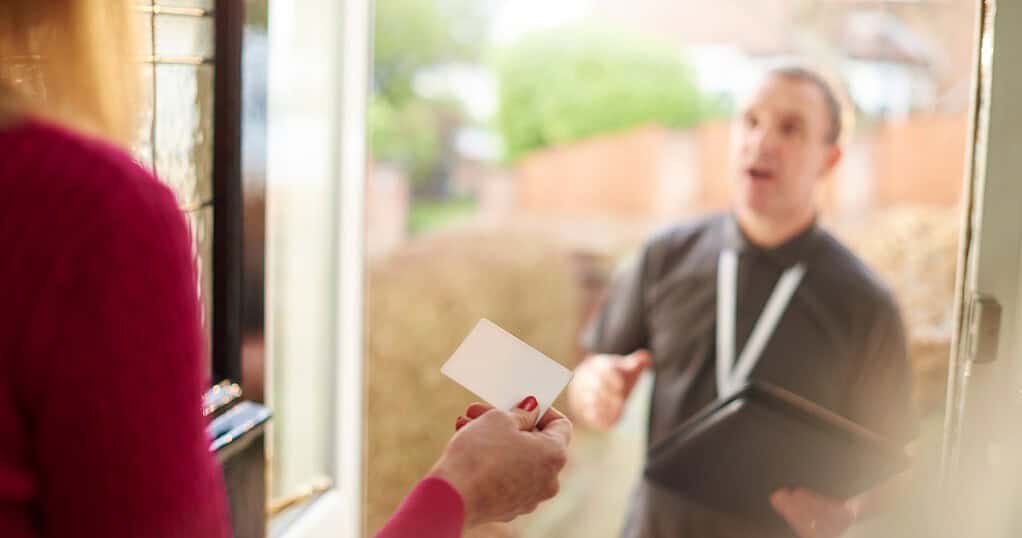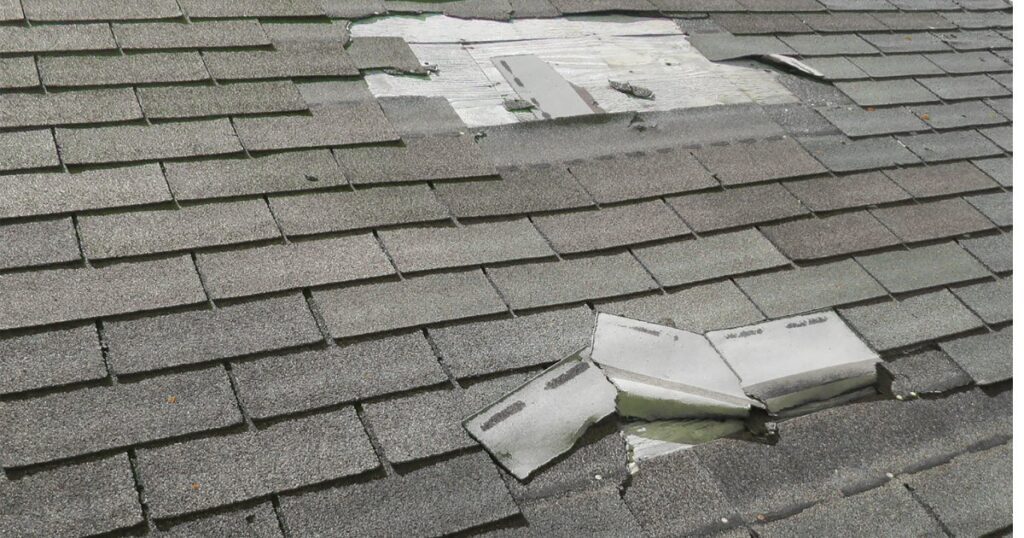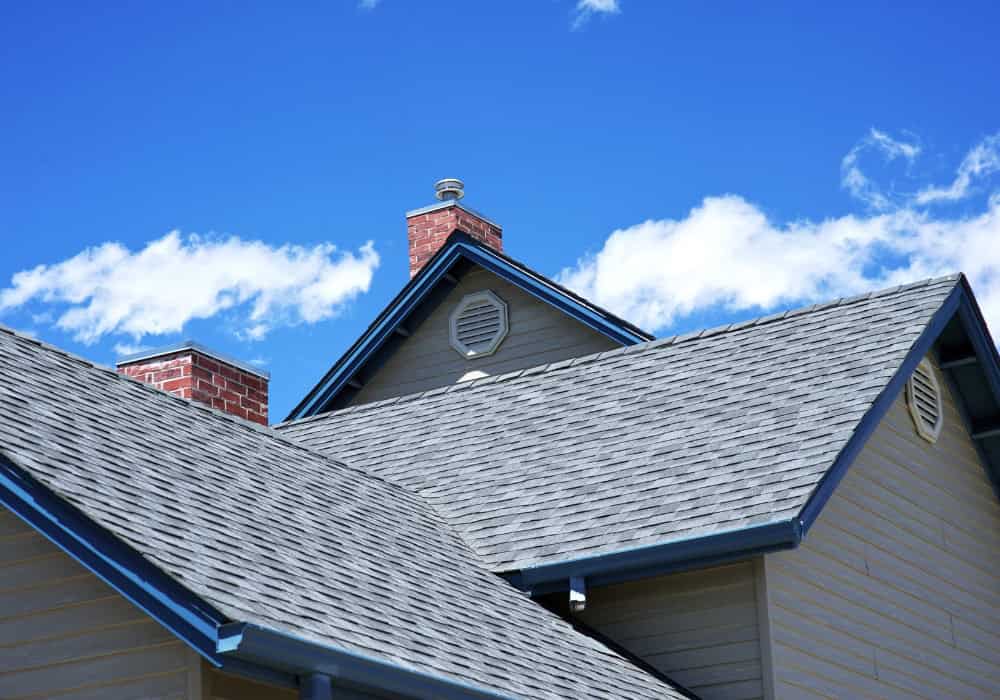There you are, enjoying a quiet afternoon, when a knock on the door disrupts your peace. It’s a representative from a roofing company, eager to talk about your roof.
While some roofing companies utilize door-to-door sales as a legitimate strategy, be cautious – there are also bad actors looking to exploit unsuspecting homeowners.
There’s a very good chance that if a roofing salesperson is knocking on your door, your home’s roof could very well have some damage. After all, it’d be a waste of time and a very hard sale for both the homeowner and an insurance company to foot the bill on a house with an already-new roof and zero damage.
But, you may not want to just jump head-first into some roofing company’s carefully-crafted sales pitch just yet.
How to Defend Your Roof against Wind and Hail Damage and Roofing Company Scams

Roofing companies vary dramatically for several different reasons, making them a mixed bag of businesses ranging from the reputable to the unscrupulous. And, even if they have 4-star or 5-star reviews on Google, they might still be engaged in dishonest business practices, including not paying their own salespeople, and dishonest communication, like the careful wording of their initial contingency agreements before you ever even file an insurance claim.
Therefore, you shouldn’t assume that roofing companies have your best interest at heart.
But, you might still have some damage that you’ll want to take care of eventually, since a roof made of even the best asphalt shingles with a perfect installation is unlikely to last more than 30 years.
That means, as a homeowner, you will have to deal with your roof someday, even if not today.
Knock Knock. Who’s There? It’s Your Local Roofer.
Here’s a breakdown of why a roofer might be knocking on your door:
Reasons for a Roofer’s Knock:
- Lead Generation: This is the most common reason. Many roofing companies supplement marketing efforts with door-to-door campaigns to find new business. They might offer free inspections or highlight recent storm damage as reasons to schedule an appointment.
- Post-Storm Check-Ups: Following severe weather, reputable roofers might canvass neighborhoods to identify potential storm damage and offer inspections.
- Local Business Focus: Small, local roofing companies might use door-to-door interactions to build relationships and establish themselves within the community.
Protecting Yourself:
- Don’t Feel Pressured: A legitimate roofing company won’t pressure you into an immediate decision. Thank them for their time and explain you’ll consider their offer.
- Beware of “Storm Chasers”: These companies often appear after storms, pushing for immediate repairs and using scare tactics. Don’t be fooled – reputable roofers will be happy to schedule an inspection at your convenience.
- Verify Credentials: Ask for a business license, insurance information, and references. Check online reviews and with the Better Business Bureau to confirm their legitimacy.
- Free Inspections Aren’t Always Free: While a free inspection might sound good, some companies use them to find problems and then pressure you into expensive repairs, sometimes fabricating issues.
- Get it in Writing: If you agree to an inspection, get a written confirmation outlining the scope of the inspection and any associated costs.
Here’s what to do instead:
- Schedule Your Own Inspection: If you suspect roof damage, contact reputable roofers in your area and request quotes.
- Leverage Technology: Many roofing companies offer online tools for virtual consultations and damage assessments using photos.
By being informed and cautious, you can turn a doorstep encounter with a roofer into a positive experience, ensuring you find a qualified professional to address your roofing needs.
Only Fools Rush In: When to File a Roof Insurance Claim, and When Not To
A recent storm rolled through, and a roofing salesperson is at your door pointing out wind or hail damage. They insist you file a claim, promoting a hassle-free repair process covered by insurance. While filing a claim can be the right move in many cases, there are situations where it might not be the best course of action for your wallet or your insurance standing.
But before we get to the upsides and downsides of filing an insurance claim on your roof for wind and hail damage, let’s look at a photo of a roof that was hit pretty badly by wind and what its chances are of insurance paying for it.
Example of Insurable Wind Damage to Your Roof that Might Turn Into an Approved Full-Replacement by Insurance
The following picture is an example of a roof that might justify filing an insurance claim.

The roof has several sections of missing or ripped shingles and the white, fiberglass layer of the shingles themselves is exposed. Eventually, this thin layer will wear away and the underlayment will directly face the elements, resulting in further dissolution, rotted wood decking, leaks, and mold. Additionally, the asphalt shingles themselves seem to have some granule loss and are upturned at the corners, which could be another indicator of age.
Asphalt shingles lose components known as “volatiles” over time due to thermal cycling of the sun and seasons. This causes them to expand and contract due to UV radiation as well as moisture absorption and release. Exposed nailheads in the adhesive strip of the shingles below missing sites also mean water leakage, even if you were to apply caulking or sealant as a temporary fix.
However, just looking at this picture might not be enough to determine if the entire roof would be replaced by insurance. For that, you’d want to inspect the other slopes for similar damage and characteristics.
At a certain level/percentage of damage encountered when compared to the entire square ft surface of the roof, an insurance company will often give a “full-approval” for a roof replacement because there’s too much damage to repair individual sections, and other factors such as age and roof vents, flashing materials, or accessories come into play.
When You Should NOT File a Storm Damage Claim on Your Roof
Here’s a scenario to consider:
A Windy Week and a Few Missing Shingles
It’s been a bit windy of late and sure enough, your roof has a black eye. But it’s not a black eye from a sucker punch, it’s a strip of shingle’s that’s blown off and now rests on the sidewalk leading to your front porch.
However, there may be no leaks ( at least for now ), and the damage is likely just cosmetic. A roofing salesperson convinces you to file a claim, highlighting the ease of a full roof replacement covered by insurance. However, consider the potential downsides:
- Deductible: Remember, you’ll have to pay your deductible before any insurance money kicks in. If the repairs are minor, the cost might be less than your deductible, making the claim pointless financially.
- Increased Premiums: Filing a claim, even for minor damage, can lead to increased premiums for several years.
- Claim History: A history of claims, even small ones, can make it harder or more expensive to get coverage in the future.
To gain a broader understanding of weather damage to your roof, it’s also beneficial to understand cui bono, or who benefits from identifying and repairing damage or replacing your roof completely?
How Roofing Scams Actually Work
Of course, there’s always that rare fly-by-night business or person that knocks your door after a big storm, points out some damage to you, promises repairs, then collects a check and you never see them again. That is definitely something you should always be concerned with. That’s why it’s always good to get independent reviews of the company before deciding to pull out your wallet using social media or your social contacts.
But what about the ever-popular insurance full-replacement knock by a seemingly established roofer with a presence in multiple states?
It goes a little something like this:
A roofing company knocks your door and offers a free inspection to evaluate the current health of your roof, likely mentioning that if the damage is sufficient, insurance may pay for all of it (less the deductible).
Regardless of how much damage they actually find, they will often exaggerate its significance and prominence in order to get you to file an insurance claim, and obtain some type of signature on a document that describes the insurance process and obligates you on the basis of a contingency, I.e. “If A happens, then you agree to B.”
That describes companies like Best Choice Roofing, who will try to get you to sign a contingency agreement to obligate you in writing to give them the roofing job if the insurance company gives full-approval to your insurance claim, while highlighting “No obligation unless full-approval by insurance.”
At other times, a roofing company like Maven will say something similar, “No obligation unless insurance approval,” but still obligate you to select them and give them the business if the insurance returns with only a partial approval for repairs.
However, what both are NOT telling you, the homeowner and consumer, is the entire story, which we will get to in a moment regarding how a partial approval is actually the worst-case scenario you could possibly achieve, because now insurance expects you to take care of the problem immediately or face losing your insurance policy altogether.
And to think, you might have gotten that full-approval by insurance if you’d only waited a few years or after the next big storm. Now you’re going to have to spend on repairs, then spend again on a replacement later for the entire roof.
Understanding Motivation: People Involved in the Wind and Hail Insurance Claim Process and Their “Why’s”
| Entity | Interests | Things to Keep in Mind |
|---|---|---|
| Homeowner | * Minimize financial loss * Ensure proper repairs * Maintain roof integrity * Protect future insurability | * Document damage with photos and timestamps before contacting anyone. * Get multiple estimates from qualified roofers. * Understand your insurance policy and coverage for wind damage. * Weigh the cost of repairs vs. filing a claim (deductible, potential premium increase). * Prioritize safety and consider hiring a professional for repairs beyond minor issues. |
| Insurance Company & Claims Adjustor | * Minimize risk and payout * Ensure repairs are legitimate and necessary * Maintain profitability | * Claims adjuster will assess damage and determine coverage under your policy. * They might negotiate repair costs with the roofer. * Be prepared to answer questions about the damage and roof maintenance history. * Don’t inflate the extent of the damage. * Keep all receipts and invoices related to repairs. |
| Roofing Company Salesperson | * Generate leads and secure business * Sell roofing services * Maintain good reputation | * Might approach homeowners after a storm to offer inspections. * May emphasize the urgency of repairs or the need for a full replacement. * Homeowner should verify the salesperson’s license, insurance, and references. * Get details about the proposed repairs, materials, and warranties. * Don’t feel pressured to make an immediate decision. |
The BIG Potential Problem that Roofing Companies Purposefully Don’t Tell You About in This Process
Filing a claim opens the door to potential problems:
- Claim Denial: Your insurance company might deny your claim if the damage doesn’t meet their criteria or if they suspect pre-existing issues. You’ll be left with the repairs and a potential blemish on your claim history.
- Partial Approval May Mean You Have to Make Repairs or Lose Coverage: Insurance companies might issue a partial approval, which means you had better make those repairs or risk losing your insurance policy down the road. Failing to make repairs from a prior claim often results in a claim denial on a new claim.
Clearly, the decision to file an insurance claim should not be taken lightly.
So, What Should You Do?
- Inspect the Roof Yourself, or Hire a Neutral 3rd Party: Safely assess the damage from the ground. Take clear photos for documentation. Or, for better results should you decide to file a claim, hire an independent roof damage inspector whose compensation may not be directly tied to the outcome of your claim.
- Consider the Cost: Get quotes for repairs and weigh them against your deductible and potential premium increases.
- Talk to Your Insurance Agent: Discuss the damage and coverage details before filing a claim.
The Takeaway:
Don’t feel pressured by a salesperson. Roofing repairs are an investment, and filing a claim should be a well-considered decision. By understanding the potential downsides and exploring alternatives, you can make an informed choice that protects your finances and your insurance standing.
Tips to Tackle Roof Damage: Hail, Wind, Age, and Beyond
Wind, hail, and time – all can wreak havoc on your roof. Here’s how to be an informed homeowner when dealing with roof damage, insurance companies, and roofing contractors:
- Be Your Own Roof Detective:
- Know the Signs: Inspect your roof (safely from the ground!) for signs of wind or hail damage like missing shingles, cracked or curled shingles, and granule loss in gutters. Age-related wear shows as blistering, cracking, and missing sealant.
- Document Everything: Take clear photos and videos of the damage, including timestamps and wide shots showing the overall roof condition.
- Navigate the Insurance Maze:
- Understand Your Coverage: Review your homeowner’s insurance policy to grasp wind and hail damage coverage specifics.
- File a Timely Claim: Contact your insurance company promptly after discovering damage. Be prepared to answer questions about the event and provide your documentation.
- Don’t Settle Too Quickly: The insurance adjuster’s initial offer might not reflect the full cost of repairs. Don’t be afraid to negotiate for a fair settlement that covers necessary repairs.
- Choose Your Contractor Wisely:
- Get Multiple Estimates: Obtain estimates from at least three qualified roofers. Look for certifications, experience with your roof type, and clear explanations of the work needed.
- Beware of “Storm Chasers”: Be wary of unsolicited offers after a storm. Reputable roofers won’t pressure you for a decision.
- Read the Fine Print: Ensure the contract details the scope of work, materials used, warranty terms, and payment schedule. Never pay in full upfront.
By becoming an informed homeowner, you can navigate the complexities of roof damage with confidence. Remember, you have a right to a fair settlement and quality repairs. Don’t hesitate to seek professional help from a public adjuster if needed.
Will Your Insurance Go Up if You File a Roof Insurance Claim Due to a Storm of Record?
Insurance companies usually go by a storm of record particular to your region as the overlapping justification to approve a no-fault claim. Usually a quick Google search and an official government website can provide more details, like this January 2024 storm of record affecting the North Carolina coast all the way up to Virginia and Delaware.
Therefore, filing a wind and hail claim isn’t guaranteed to raise your future premiums, but it may still increase the chances. Here’s why:
- Insurance companies view claims as risk indicators: They see a history of claims as a sign you’re more likely to file another one in the future. This translates to a higher risk for them, potentially leading to a premium increase.
- Severity of the claim matters: Minor claims might have less impact than major ones.
- Company policy and local factors: Insurance companies have different risk assessment models. Your location’s hail or wind frequency can also play a role.
Here are some things to consider:
- Deductible vs. Repair Cost: If the repairs cost less than your deductible, filing a claim might not be financially beneficial.
- Claim History: A single claim likely has a smaller impact than multiple claims within a short period.
- Talk to your agent: Discuss the damage and your specific policy with your insurance agent. They can give you a better idea of the potential impact on your premiums.
Alternatives to Consider:
- Minor Repairs: If the damage is minor and doesn’t affect the roof’s integrity, you might consider handling the repairs yourself or waiting until you have other roof work done to save on overall costs.
- Negotiate with Roofer: Negotiate directly with a roofer for repairs without involving insurance. This might be a viable option for minor damage.
Remember:
- Document the damage with photos and timestamps before contacting your insurance company or a roofer.
- Get multiple estimates for repairs before making a decision.
When is the right time to file an insurance claim for wind or hail damage?
This table provides a framework for decision-making. Remember, the ball in in your court and there’s no reason to make an impatient decision, regardless of what you choose to do.
| Scenario | Description | Financial Considerations |
|---|---|---|
| DIY Repair | Minor damage (few missing shingles, small leaks) | * Repair cost significantly less than your deductible. * You are comfortable and experienced with safe roof work (proper safety gear, working from a stable ladder). |
| Wind Insurance Claim (Repair) | Significant wind damage (widespread missing shingles, exposed underlayment) | * Age of roof is nearing lifespan (around 15-20 years) but not so old for automatic replacement without storm damage. * Repair cost, based on adjuster’s assessment, is higher than your deductible. * Local market has reasonable replacement costs and qualified roofers. * Your insurance policy clearly covers wind damage and roof repair under such circumstances. |
| Wind Insurance Claim (Replacement) | Extensive wind damage + nearing end-of-life roof | * Age of roof is nearing or exceeding its lifespan (typically 15-20 years for asphalt shingles). * Extensive wind damage justifies full roof replacement according to your insurance company’s standards. * Repair cost, considering depreciation for an older roof, is close to or exceeds the replacement cost. * Out-of-pocket expense after the deductible is minimal (covers minor upgrades or specific features not covered by insurance). |
Keep in mind you may still have to deal with the real problem of roof damage in the future, but you could have anywhere from months to years before it becomes a serious problem.
The Ideal Scenario for a Homeowner Dealing with Roof Damage, Roofers, and Insurance
Here’s the ideal scenario for filing a wind damage insurance claim for your roof, maximizing your benefit:
Damage Meets Specific Conditions:
- Extent of Damage: The wind damage is significant enough to warrant a full roof replacement according to your insurance company’s standards, not just a patch-up repair. This could include widespread missing or broken shingles, exposed underlayment, or significant granule loss.
- Age Threshold: Your roof is nearing the end of its expected lifespan (typically around 15-20 years for asphalt shingles) but not so old it’s automatically flagged for replacement without storm damage. This sweet spot allows the insurance company to justify a full replacement under storm damage coverage.
Financial Advantage:
- Deductible vs. Replacement Cost: The cost to replace the entire roof is significantly higher than your deductible. This means the insurance company shoulders most of the financial burden.
- Minimal Out-of-Pocket Expense: Ideally, after paying your deductible, you have minimal additional out-of-pocket costs. This might involve covering a small portion of upgraded materials or specific features not covered by your insurance.
Additional Factors:
- Local Market: Replacement costs in your area are reasonable, and there’s no shortage of qualified roofers. This ensures competitive quotes and prevents inflated repair estimates by a roofing company.
- Policy Coverage: Your homeowner’s insurance policy explicitly covers wind damage and offers clear guidelines for roof replacement under such circumstances.
Remember: This is an ideal scenario, and achieving all these conditions might not always be possible. However, it provides a good framework for making an informed decision.
What is the average cost of repairing a roof with only minor damage like missing shingles?
The exact cost of repairing minor roof damage depends on several factors, but here’s a breakdown to help you estimate and decide whether to involve insurance:
Deductible Comparison:
The average wind-hail insurance deductible in the US is around $1,500 – $2,500. If your minor repairs cost significantly less than your deductible, filing a claim might not be financially beneficial.
Here’s why you might avoid insurance for minor repairs:
- Premium Increase: Filing a claim can potentially increase your insurance premiums for several years.
- Claim History: A history of claims, even minor ones, can affect your ability to get future coverage or lead to higher premiums.
DIY vs. Contractor:
- DIY Repairs: If you’re comfortable and have some DIY experience, fixing minor shingle repairs might be a possibility. However, safety is paramount. Work on a stable ladder and wear proper safety gear. If you’re unsure, it’s best to hire a professional.
- Contractors: Hiring a contractor ensures the repairs are done correctly and come with a warranty. However, choosing a reliable general contractor is not always easy either.
So, is it even still worth filing a wind-and-hail insurance claim?
Consider these points:
- Compare Repair Cost vs. Deductible: If repairs are significantly less than your deductible, skip the insurance claim.
- Factor in Potential Premium Increase: Weigh the cost of repairs against the potential for increased premiums over time.
By comparing repair costs, your deductible, and the potential impact on premiums, you can make an informed decision about how to address minor roof damage.
Factors Affecting Repair Cost:
- Shingle Type: As the complexity of the shingle increases, so does the repair cost.
- Extent of Damage: A few missing shingles will cost less to repair than widespread damage.
- Labor Rates: Labor costs vary depending on your location.
Estimated Repair Costs (including labor):
- 3-Tab Shingles: While technically going out of style in most areas, these are the simplest to repair, with costs typically ranging from $100 to $300 per repair area.
- Architectural Shingles: Growing in prevalence due to their increased weather resistance and layered construction, repairs for architectural shingles might cost $150 to $400 per repair area.
- Upgraded Architectural Shingles (like CertainTeed Landmark or Owens Corning Duration): These require more specialized knowledge for repairs, potentially pushing the cost to $200 to $500 per repair area.
Additional Considerations:
- Rotted Decking: Repairing rotted decking underneath the shingles adds to the overall cost. Expect an additional $50 to $150 per square foot for deck repairs. If someone inspects your roof and says they see the underlayment, there’s a good chance you’ll need to replace an entire 100 sq. foot section of shingles because the decking is rotted out.
- Replacing Exploded Nail Heads: This is a relatively minor repair, typically costing around $2 to $5 per nail head.
Here’s why repairs might be necessary even if under the deductible:
- Preventing Leaks: Minor damage left unrepaired can lead to leaks and more extensive (and expensive) problems down the road.
- Maintaining Roof Integrity: Early intervention can extend the lifespan of your roof and prevent a full replacement sooner.
By understanding the average repair costs and the importance of addressing minor damage, you can make informed decisions about maintaining your roof and avoiding potential future problems.
How hard is it to replace a few missing shingles or full tabs of shingles from a roof?
The process of patching up or replacing missing shingles depends on the extent of the damage and the type of shingle you have. Here’s a general breakdown for both scenarios:
Patching Up Missing Shingles:
- Safety First: Ensure you have proper safety gear like work gloves, a sturdy ladder, and fall protection (especially important for steeper roofs).
- Locating the Damage: Identify the missing shingles and assess the surrounding area for any signs of further damage like warped or cracked shingles.
- Prying Up the Surrounding Shingles: Carefully use a flat pry bar to lift the tabs of the shingles directly above the missing one(s). Be gentle to avoid damaging them.
- Removing the Nails: Once the shingle above is lifted, locate and remove the nails holding the damaged shingle in place.
- Slide Out the Damaged Shingle: Carefully pull out the missing shingle.
- Inspect the Underlayment: Check the waterproof underlayment beneath the shingles for any tears or damage. If there’s damage, it will need repair before proceeding.
- Slide in the Replacement Shingle: Slip the new shingle under the lifted tabs of the shingle above it, ensuring proper alignment.
- Nail it Down: Use roofing nails (typically galvanized with a wide head) to secure the new shingle through the pre-drilled holes and into the roof deck below. Don’t over-nail and avoid hitting the nails already securing the shingle above.
- Re-sealing the Shingles: Apply a small amount of roof cement under the lifted tabs of the surrounding shingles to create a watertight seal.
- Repeat: Continue this process for each missing shingle.
Replacing Full Tabs of Missing Shingles:
- The process is similar to patching up a single shingle, but with additional steps:
- Removing a Larger Area: You might need to remove a larger section of shingles above the missing tabs to access the underlying layers and ensure proper installation of the replacement shingle course.
- Replacing Underlayment (if needed): If the underlayment is damaged, carefully cut away the affected area and replace it with a new piece of underlayment, following the manufacturer’s instructions for proper overlap and sealing.
- Replacing Shingle Lath (if needed): In some cases, the wooden lath (support structure under the shingles) might be damaged. You might need to replace the damaged section with new lath.
- Sliding in the New Shingle Course: Carefully slide the new shingle course (multiple shingles) underneath the remaining shingles above, ensuring proper alignment and interlocking.
- Nail and Seal: Secure the new shingle course with nails and ensure proper sealing around the edges.
Important Considerations:
- Matching Shingles: Always use shingles that match the existing ones in terms of material, color, and brand (if possible) to ensure a proper fit and aesthetic consistency.
- Roof Pitch: Roofs with a steeper pitch require extra safety precautions and might be best left to professionals.
- Complexity Increases with Damage: The process becomes more complex with extensive damage or the need to replace underlying structures. Consider hiring a professional roofer for such situations.
Safety First:
Remember, safety is paramount. If you’re unsure about your ability to safely access your roof or complete the repairs, it’s always best to consult a qualified and licensed roofing contractor.
Conclusion: to Roof or Not to Roof, That is the Question
A homeowner must realize that eventually, roof shingles will naturally fail and need to be replaced. The average lifespan of a roof in a moderately windy and sunny climate in the US is 20 – 30 years. Knowing this, it’s only a matter of when, not if, your roof will need to be replaced whether in whole or in part.
Navigating this scenario wisely will ensure that you maximize opportunity and save money in the long-run while protecting your home’s value and your home life from annoying leaks and potential structural damage.
Choose your course of action wisely.
For an actually FREE qualified roof inspection anywhere in the USA, Gulf Coast or East Coast, contact us. You can actually push a ladder up to your own roof in many cases and take photos with a zoom lens.
We’re happy to help you make your own decision to file a wind-and-hail damage claim.
- I Asked Google AI to Confirm SEO Best Practices for Single Location Business with Multiple Service Areas - June 2, 2024
- Why Roofers Knock: A Homeowner’s Guide to Protecting Your Home from Storm Damage and Bad Business - May 14, 2024
- Ditch the Expensive Daily Starbucks Coffee with Clio and Save - April 20, 2024




Pingback: How Best Choice Roofing Created a Work Culture of Greed and Distrust - USA Eyes Fraud